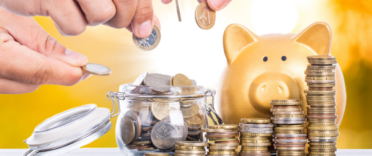
But with the opportunity to make a healthy return come responsibilities, too. Interest earned outside tax wrappers like ISAs or pensions can be liable for tax. In this article, we explain whether you should be paying tax on your savings interest, how to go about it, and whether you can lower your tax bill.
Personal savings allowance explained
Interest on your savings is paid to you gross. The tax you owe is, therefore, not withheld by the banks before passing the interest you earned on to you. Your personal savings allowance is the amount you can earn in interest before you have to start paying tax on it. This allowance is based on your tax band. If you're a basic rate taxpayer, your personal savings allowance is typically £1,000. This means you can make £1,000 in interest before you're liable for tax. If you're a higher-rate taxpayer, you have a reduced personal savings allowance of £500. And, if you're an additional rate taxpayer, you don't get a personal savings allowance.
The table below sums this up and includes the typical amount you'd need to earn before hitting each tax band in 2024/25.
| Tax Band | Taxable Income | Personal Savings Allowance |
| Basic rate | £12,571 - £50,270 | £1,000 |
| Higher rate | £50,271 - £125,140 | £500 |
| Additional rate | £125,140+ | £0 |
This is how it works in a nutshell.
You can use up your personal savings allowance on interest you've earned from various sources not covered by tax wrappers. These can include but are not limited to:
- Savings accounts with banks and building societies
- Trust funds
- Credit union accounts
- Peer-to-peer lending (Not including Innovative finance ISAs)
This covers most situations where adults earn interest from savings accounts in the UK. However, different rules may apply to those receiving savings interest or dividends from foreign investments. And, if the interest earned is in a children's account, then the allowances and rules are different, too.
If you have a joint savings account, any interest you earn will be split between the two of you for tax purposes. So if your joint account earns £1,000 in interest over the year, your "share" will be £500, which means you'll have used £500 from your personal savings allowance.
How to boost your tax free interest allowance with the starting savings rate allowance
Things can get a little more complicated if you haven't used up your personal allowance, which is currently £12,570; this is the amount you can earn tax-free each year from wages and other income. If this applies to you, then you will likely be able to earn more tax free interest on your savings than people with higher incomes from their jobs.
Let's say you've earned £6,000 from part-time work over the financial year. This leaves you with at least another £6,570 you can earn tax-free from other sources. If, for example, you earn £6,570 from interest on your savings, you wouldn't pay tax on this amount because you'd still be within your personal allowance threshold. On top of that, you would also get your £1,000 personal savings allowance as discussed above.
In addition to this, you could also benefit from the starting rate for savings. This allowance was introduced in April 2015 to help low earners pay less on their savings. The savings rate allowance can help you earn up to £5,000 per year tax-free in addition to your personal savings allowance.
In order to qualify for the full starting rate for savings allowance, you need to earn below the basic rate income tax threshold which is currently £12,570. If you earn under this amount, you can earn an additional £5,000 in interest tax free. However, for every £1 you earn over this amount, you lose £1 of the starting savings rate allowance. So, for instance, if you earn £13,750 per year, then your starting savings rate allowance would be £4,000 instead of the £5,000 you would receive if you make under £12,570.
We discuss the personal savings allowance and starting savings rate in much more detail in our article on boosting your personal savings allowance.
How to work out how much taxable interest you've earned
Not all the interest you earn will count towards your annual personal savings allowance. You only need to "count" interest that you've received and can access during that financial year. So, for instance, interest that you're accruing as part of a fixed-term account, payable outside of the current tax year, won't count towards your current personal savings allowance.
But, if you're having interest paid into your account on a monthly basis and you can go spend it at will, then this will count towards your personal savings allowance because you can access it.
Interest paid by your bank or building society isn't taxed at source, so you'll need to add it all up to work out whether you're over the threshold. If you have a joint account with your partner, you only need to add up half the interest that the account earned.
Typically, your bank or building society will issue a statement which tells you how much interest you have earned after the end of the financial tax year. This can help with filling out your tax return.
How to pay the tax you owe on savings interest
If you've used up your personal savings allowance, you may need to pay tax on the savings interest you've earned. You pay tax at your usual income tax rate based on your income tax band.
Depending on your circumstances, the tax you owe can be collected via your tax code, or you may need to complete a self-assessment, particularly if you make interest over a specific threshold. Read on to find out how to pay your tax bill below.
Paying tax on savings interest through your tax code
People who get a pension or are employed will usually have their tax for savings interest collected by HMRC automatically. Financial institutions report the interest earned to HMRC at the end of each tax year. HMRC then changes your tax code accordingly and automatically collects the tax you owe.
If you don't get a pension and aren't employed, HMRC will still find out about any interest you've earned via your bank. They'll contact you to let you know if you owe any tax and how to pay it. In some cases, you might need to pay tax on your savings through self-assessment.
Paying tax on savings interest through self-assessment
If you've already completed a self-assessment tax return form, you should report the interest you earned on savings there. You'll also need to fill out a tax return if you make more than £10,000 in interest from savings and investments during a specific tax year.
If you are unsure whether you need to fill out a self-assessment tax form, there's a handy HMRC tool that'll tell you whether you need to file a return based on your individual circumstances.
How to register for self-assessment
Let's say you need to fill out a tax return to report interest you've earned between April 2024 and April 2025. As the financial year hasn't ended yet, you have plenty of time to get organised before you can submit your return. If you haven't registered for self-assessment before and this is your first time filling out a tax return, there are three deadlines you need to be aware of.
- You will need to register for self-assessment before 5th October 2025. - This process can take several weeks even if you're based in the UK, so you'll need to register well before the 5th of October if you want to avoid potential fines.
- You will need to submit your paper tax return before 31st October 2025. - If you don't want to submit your tax return online, you can request a paper return via the GOV.UK website. You'll need to submit your return before 31st October 2024.
- You will need to submit your online tax return and pay any tax you owe before 31st January 2026. - This is the deadline to submit tax returns for 2024/25. You'll need to wait until the tax year ends to obtain your interest statement from the bank or building society you're with so you can complete and submit your tax return.
To register for self-assessment online, you'll need a Government Gateway user ID and password. You can create these sign-in details online in just a few minutes. Once you've created your Government Gateway details, you can log in and request a Unique Taxpayer Reference (UTR) number to fill out a tax return. To request this, you'll need to fill out a form telling HMRC about yourself and your business. You should then receive this number by post within 15 days if you're in the UK. It can take up to 21 days if you're abroad.
You might be able to access your UTR before it arrives in the post via the HMRC app or by logging into your Government Gateway account. This is because it's likely to appear in the app as soon as it's generated and before it gets to you by post. HMRC has a helpful video showing you exactly where to look for your UTR via the app.
How to pay tax on savings interest for the 2023/24 financial year
You'll notice the deadlines above are based on this financial year's returns. However, if you earned interest between 2023 and 2024 and just realised you need to fill out a tax return, you have until 31st January 2025 to do so online.
Here's what to do if you need to fill out a self-assessment for the 2023/24 financial year:
- If you've previously submitted a tax return, all your details will still be registered with HMRC, even if you haven't submitted one in the last couple of years. - All you'll need to do is reactivate your account and submit the form and pay what you owe before 31st January. You can do this by signing in using your Government Gateway user ID and password. You'll need your Unique Taxpayer Reference (UTR) number as well.
- If you haven't previously submitted a tax return, you need to register for self-assessment as soon as possible. - You've missed the 5th October deadline, but as long as you submit your tax return and pay your tax before January 31st, you're unlikely to face any penalties or fines. As discussed, it can take a couple of weeks to receive your credentials, so you must begin the process immediately. Use this HMRC tool to help you figure out how to register if you're unsure.
If you've registered before but can't find your Unique Taxpayer Reference Number (UTR), you should be able to find it:
- Online via your Personal Tax Account
- Within the HMRC app
- On previous HMRC tax returns or documents you've received in the post
If you still can't find it, you can contact HMRC and request that they send it to you. They'll post a copy to you, but this can take up to 10 days, so it's best to put in the request sooner than later. If you've already requested a UTR, you can check when HMRC is likely to respond via their tool.
How to pay less tax on savings
Using a tax wrapper like an Individual Savings Account (ISA) or personal pension is a good way to pay less tax on your savings interest. A tax wrapper is a term used to refer to an account that protects your savings and investments from tax. Some examples of tax wrappers include:
With an ISA, for example, you can save up to £20,000 per year tax free, meaning you don't need to pay any tax on the interest. It doesn't count towards your personal savings allowance either.
If you have children, you can contribute up to £9,000 to each child's Junior ISA tax free as well. The money, however, is locked into the Junior ISA until your child turns 18 and then it belongs to them. Some Junior Cash ISAs currently pay up to 4.50% annual interest, so this might be worth considering if you're looking for a tax-efficient way to save for your child's future.
A cash ISA can be used in the same way as an interest-earning savings account. A Stocks and Shares ISA comes with the potential for more growth, but the capital is at risk. If you want to explore some of the best cash ISAs on the market, check out our fixed rate ISA comparison table.
Do I have to pay tax on my savings in the UK?
To sum up, you don't need to pay tax on the savings you've accumulated, but you may need to pay tax on the interest you've earned on your savings, if this is above your personal savings allowance.
Whether you need to pay tax depends on your circumstances and, in particular, how much other income you've earned in a given year. In some circumstances, you'll need to register for self-assessment and fill out a tax return to pay tax on the interest you've earned.
There are ways to avoid paying tax on your savings, particularly if you use tax wrappers like ISAs, pensions, and NS&I premium bonds effectively.






